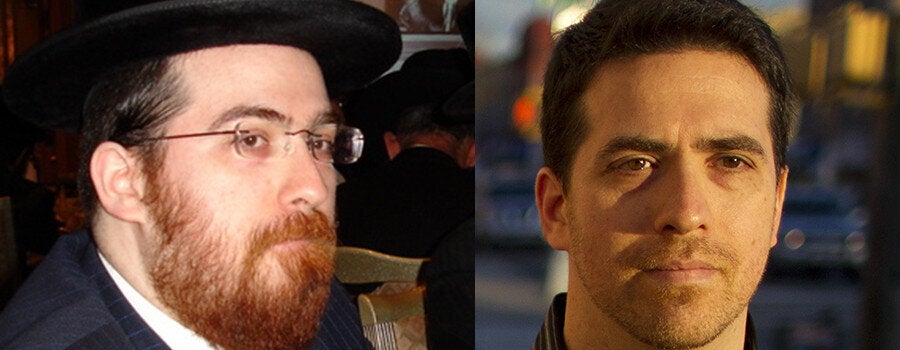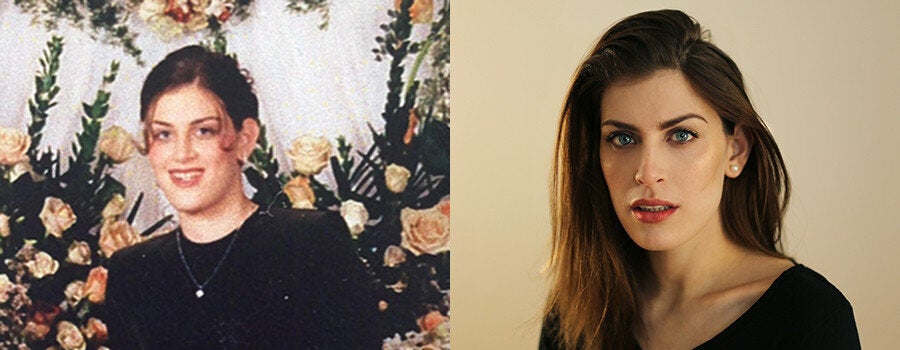Shulem Deen’s first steps away from Hasidic Judaism were in the direction of a radio.
Defying his community's express prohibitions against secular media, Deen waited until his wife and children were sleeping. Then he leaned in close to the small tape player in his home -- the one whose radio he hadn't had the heart to disable. He turned it on and began to listen.
“I switched the dial from one station to another, commercials for medical malpractice attorneys, car dealerships and department store blowout sales filling me with forbidden pleasure,” Deen wrote in his recently released memoir, All Who Go Do Not Return. “I was like a visitor from a different era encountering our modern one, captivated by its very mundaneness.”
Indeed, leaving his home -- and Hasidism -- might as well have been time travel. Deen was born into an ultra-Orthodox Jewish family in Brooklyn, and lived from adolescence in New Square, New York. The Rockland County hamlet is made up entirely of Hasidim from the Skver sect, which originated in Skvyra, Ukraine. The society Deen inhabited for much of his adult life is deeply isolated from the modern world: The Skverer Hasidim, like most ultra-Orthodox Jews, eschew the Internet, television and non-Jewish music, and adhere to strict limitations on diet and dress.
For Hasidim, life orbits around service to God. In communities scattered throughout the northeastern U.S., hundreds of thousands of ultra-Orthodox Jews have created insular, inward-facing worlds, islands of radical piety in the midst of America’s bustling secular life. Hasidic men lead their lives immersed in the Talmud, one of Judaism’s holiest texts. Yiddish, not English, is the language spoken on the streets. And everything, from birth to marriage to death, is supervised by tight-knit communities committed to enforcing pious norms for themselves and their neighbors. People are born, live, and die within the confines of family and faith. No one leaves.
Except the ones who do. For people who exit Hasidic communities, it can mean total rupture: Leaving Hasidism means leaving behind family, community and the only way of life they have ever known, in favor of a secular world whose realities they are ill-prepared for. These individuals call themselves OTD, or “off the derech,” the Hebrew word for “path.” The new roads they take are often fraught with difficulty. But OTD individuals have begun to find one another -- sharing the challenges, and triumphs, of the journey out.

After leaving Hasidism, Deen endured a divorce, struggled to find a job and became estranged from his five children. He found himself deeply depressed in his newfound isolation.
“I was cut off completely from my previous community, and I had no connections in the outside world,” he told The Huffington Post. “I had no friends who were not religious.”
That’s when Deen reached out to Footsteps, an organization that works to support individuals making the transition out of the ultra-Orthodox world.
Founded in 2004 by a formerly Hasidic woman, Footsteps has aided 1,000 people to date, according to Lani Santo, the current director. The organization offers a number of programs ranging from educational services to peer support groups.
"Footsteps provides absolutely crucial services -- sometimes lifesaving services," said Deen. "Without Footsteps -- I’ve had some serious episodes of depression –- without Footsteps I don’t know if I would be alive now. It was really that crucial. It was lifesaving to me, and I know it was lifesaving to many others."
The educational services that Footsteps offers teach skills most of us take for granted: talking to someone of the opposite gender; reading a restaurant menu; writing a resume.
Men leaving the Hasidic community have an extra hurdle to clear: Hasidic boys’ schools often sidestep state educational requirements, eschewing subjects like science and math to immerse students in a rigorous curriculum of Talmud study. Many adult male Hasidim read English at only a fourth- or fifth-grade level, Santo told HuffPost.
“They need a GED en route to college if that’s what they want,” she explained, adding that finding employment in the Hasidic world is facilitated by a vibrant, informal network within the religious community. "The risks are great, and the courage it takes [to leave] is pretty astounding.” Women face a different, if no less profound, set of challenges. Deen calls the Hasidic world a “deeply chauvinistic” society -- one in which women are categorically barred from community leadership roles and their lives shaped by stringent conceptions of modesty. But because girls are prevented from studying the Talmud, secular education is more widespread in girls’ schools.
“Girls, because what they do with their time is considered less important, there’s more laxity about what they read,” Leah Vincent, a board member of Footsteps who left the ultra-Orthodox world in her teens, told HuffPost.
But despite comparatively better access to education, women who leave the Hasidic world can find themselves deeply vulnerable due to the sex segregation and rigidly enforced gender roles they've encountered from an early age.
In her haunting memoir, Cut Me Loose: Sin and Salvation After My Ultra-Orthodox Girlhood, Vincent wrote about how her sheltered upbringing left her ill-prepared to break with her faith. In her late teens, during her first intimate relationship with a man, she found herself unable to refuse his advances -- and ultimately experienced a traumatic rape.
"No one should have to pay the price for freedom that I had to pay," Vincent said. “I had to recognize that I had a right to my own opinion, that my entire self didn’t have to make the man in front of me feel good. My mom defined herself as an enabler -- she enabled my father to study. Women enable men and children. That was part of my identity. That’s something I’m still working on.” For Vincent and many others who have made the perilous transition out of the Hasidic world, Footsteps is a crucial resource -- not just for its career resources and legal aid, but for the community it provides. Vincent said that through her involvement with the organization, she hopes to prevent others from enduring what she did.
"I only found out about Footsteps after the worst of my journey -- the story I tell in my memoir -- happened, but there I found and connected with people with similar experiences," Vincent said. "I realized I wasn’t alone; other people had faced these issues."
Melissa Weisz, an actress in her late 20s who left the Satmar Hasidic community soon after her marriage at 19, told HuffPost that Footsteps helped her build a brand-new life -- from her identity to her wardrobe.

When she left her old life, Weisz said, “I was putting myself through school, working overnight at group homes. I was going to do anything I had to do to make sure I was going to live.”
"I looked to Footsteps because I felt like an outsider,” she continued. “I remember looking at myself in the mirror -- I saw myself in jeans, but on the inside I felt the mirror was lying to me. I was convinced that everyone could see that I was supposed to be in a skirt, everyone could see through me."
And the cohort of those who seek support at Footsteps is growing.
“We’ve entered a network of at least 3,000 or 4,000 people,” Santo said. “New members have increased each year significantly. In 2010, the number of new-member intake interviews was 46. Last year, in 2014, it was 142 -- a 150 percent increase.”
The ultra-Orthodox population itself is growing by leaps and bounds, in large part due to a community culture that encourages having as many children as possible. According to the Pew Research Center, Orthodox family size is nearly double that of the national average. Recently, Santos said, Footsteps affiliates organized a Mother’s Day barbecue in Prospect Park, Brooklyn. Many attendees’ mothers were no longer speaking to them. Others were mothers themselves, locked in custody battles for children they might never be able to speak to again.
But thanks to Footsteps, Facebook groups and other websites, those who have left the ultra-Orthodox world are starting to find each other -- and face their struggles together. On a path that diverges from the unbending arc of life prescribed by tradition, they've begun recognizing each other on the road.
And freedom itself is its own kind of revelation, says Weisz. She recounted a shining moment from her early twenties: going to the beach.
“It was so freeing that I got to feel the water on my skin. We had that in pools growing up, but we had to be totally covered up,” she said. “It was the first time that I was actually in the open -- immersed. It felt like I was part of the world, that I was free.”